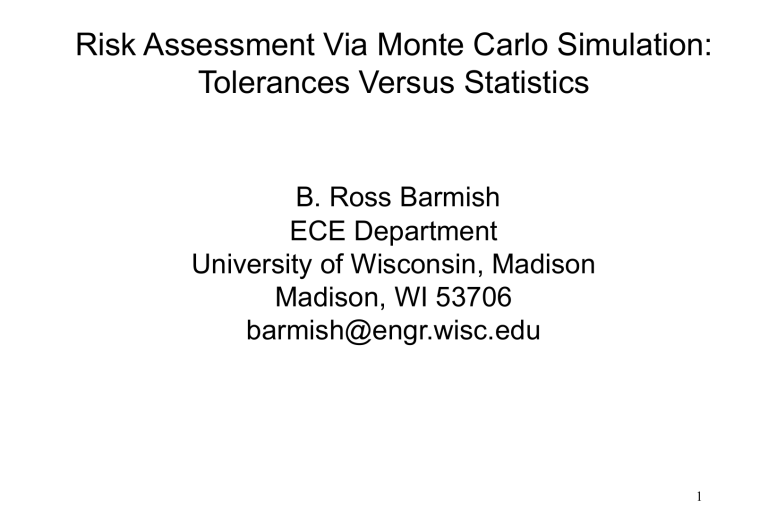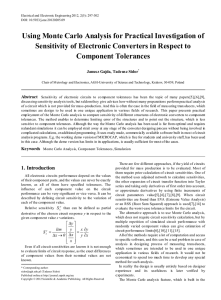Risk Assessment Via Monte Carlo Simulation: Tolerances Versus Statistics B. Ross Barmish

Risk Assessment Via Monte Carlo Simulation:
Tolerances Versus Statistics
B. Ross Barmish
ECE Department
University of Wisconsin, Madison
Madison, WI 53706 barmish@engr.wisc.edu
1
COLLABORATORS
• A. C. Antoniades, UC Berkeley
• A. Ganesan, UC Berkeley
• C. M. Lagoa, Penn State University
• H. Kettani, University of Wisconsin/Alabama
• M. L. Muhler, DLR, Oberfaffenhofen
• B. T. Polyak, Moscow Control Sciences
• P. S. Shcherbakov, Moscow Control Sciences
• S. R. Ross, University of Wisconsin/Berkeley
• R. Tempo, CENS/CNR, Italy 2
Overview
• Motivation
• The New Monte Carlo Method
• Truncation Principle
• Surprising Results
• Conclusion
3
Monte Carlo Simulation
• Used Extensively to Assess System Safety
• Uncertain Parameters with Tolerances
• Generate “Thousands” of Sample Realizations
• Determine Range of Outcomes, Averages, Probabilities etc.
• How to Initialize the Random Number Generator
• High Sensitivity to Choice of Distribution
• Unduly Optimistic Risk Assessment
4
It's Arithmetic Time
• Consider
1 + 2 + 3 + 4 + 5 + L + 20 = 210
• Data and Parameter Errors
• Classical Error Accumulation Issues
(1 § 1) + (2 § 1) + (3 § 1) + L (20 § 1) = 210 § 20
5
Actual Result
Two Results
0.5
0.4
0.3
0.7
0.6
1
0.9
0.8
0.2
0.1
0
190 195 200 205 210 215 220 225 230
Student Version of MATLAB
Alternative Result
190 · SUM · 230
6
I
1
1 V
+
_
10 R
1
I
2
10
R x
+
5
R
2
_
10
I
3
I
4
Circuit Example
Output Voltage
• Range of Gain Versus Distribution
7
k
1 b
1 k
2 b
2 k
3 b
3 k
4 b
4 y
F
More Generally
• Desired Simulation
8
• Interval of Gain
• Monte Carlo
Two Approaches
500
400
300
200
100
0
0.45
1000
900
800
700
600
0.5
0.55
0.6
0.65
0.7
0.75
0.8
0.85
0.9
Student Version of MATLAB
• How to Generate Samples?
Gain Histogram: 20,000 Uniform Samples
9
Key Issue
What probability distribution should be used?
Conclusions are often sensitive to choice of distribution.
• Intractability of Trial and Error
• Combinatoric Explosion Issue
10
Key Idea in New Research
Classical Monte Carlo
Statistics of q
New Monte Carlo
Bounds on q
Random
Number
Generator
Samples of q
F
System Model
Samples of F(q)
New
Theory
Statistics of q
Random
Number
Generator
Samples of q
System Model
F
Samples of F(q)
11
The Central Issue
What probability distribution to use?
12
Manufacturing Motivation
13
0.06
0.05
0.04
0.03
0.02
0.01
0.1
0.09
0.08
0.07
-15 -10 -5 0 5 10 15 20
Distributions for Capacitor
14
Interpretation
15
Interpretation (cont.)
Bounds on q
New
Theory
Statistics of q
Random
Number
Generator
Samples of q
System Model
F
Samples of F(q)
16
r
1
t
1 t
1 x
1
r
2
t
2 t
2 x
2
Truncation Principle
17
Example 1: Ladder Network
V in
R 1
R
2
R 3
R 4
R 5
...
...
R n-2
R n-1
R n
+
V out
-
• Study Expected Gain
18
Illustration for Ladder Network
19
Example 2: RLC Circuit
Consider the RLC circuit
I 1
L
R 2
+
C
2
V
0
-
20
Solution Summary For RLC
1.4
1.2
1
0.8
0.6
1.8
1.6
x 10 -6
0.4
0.2
0
0 0.5
1 1.5
2 t1
2.5
3 3.5
4 4.5
x 10 -7
21
Current and Further Research
• The Optimal Truncation Problem
• Exploitation of Structure
• Correlated Parameters
• New Application Areas; e.g., Cash Flows
22






